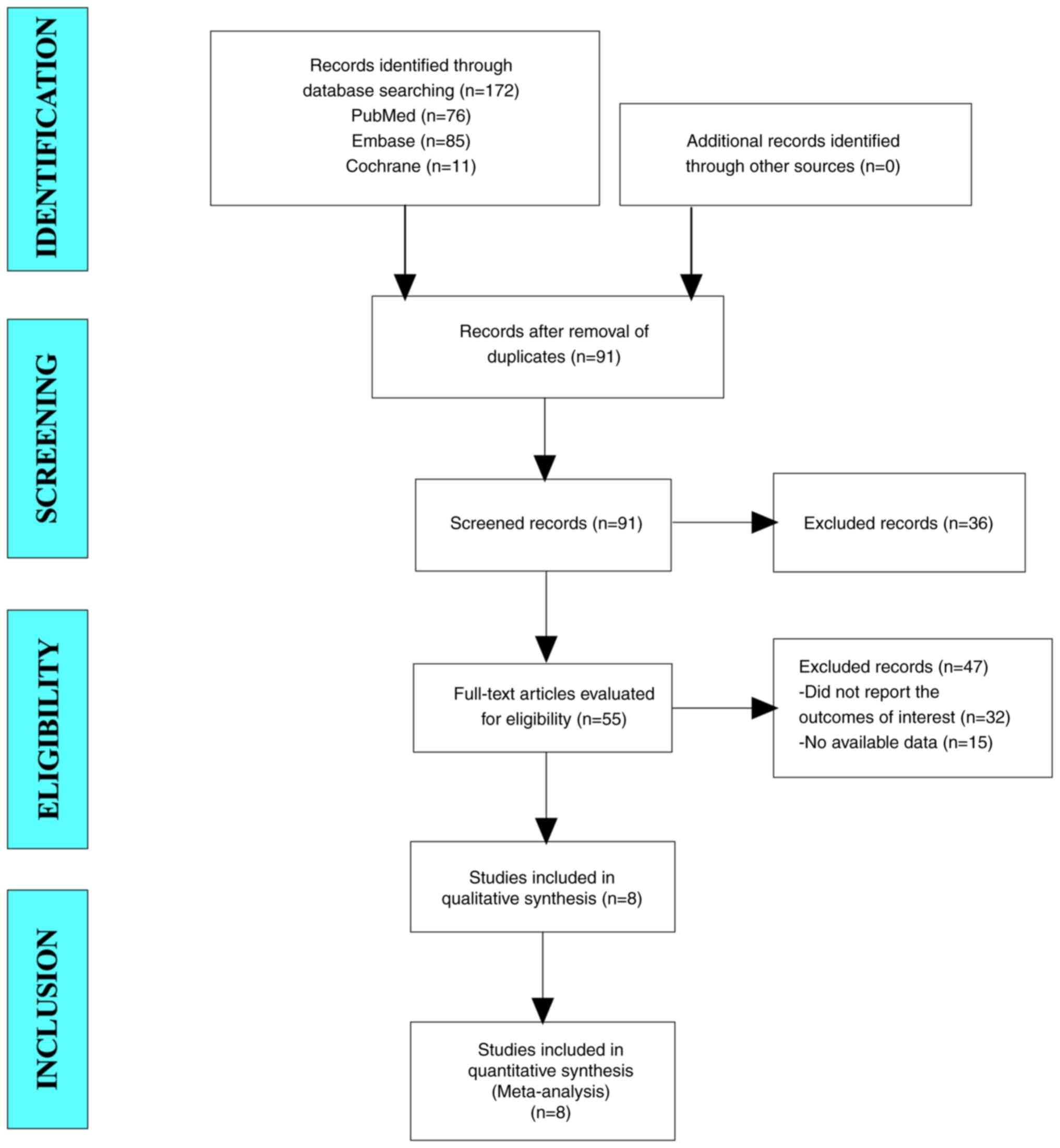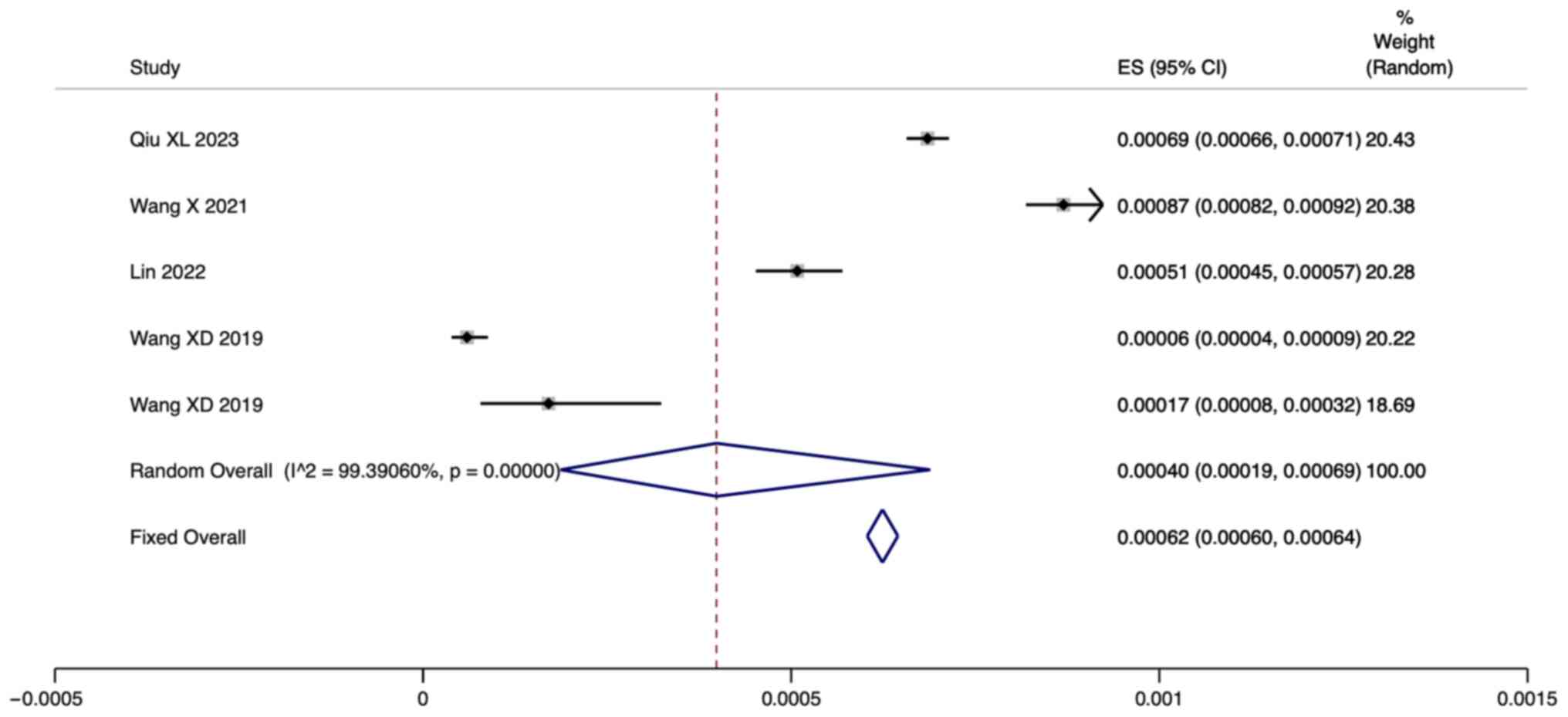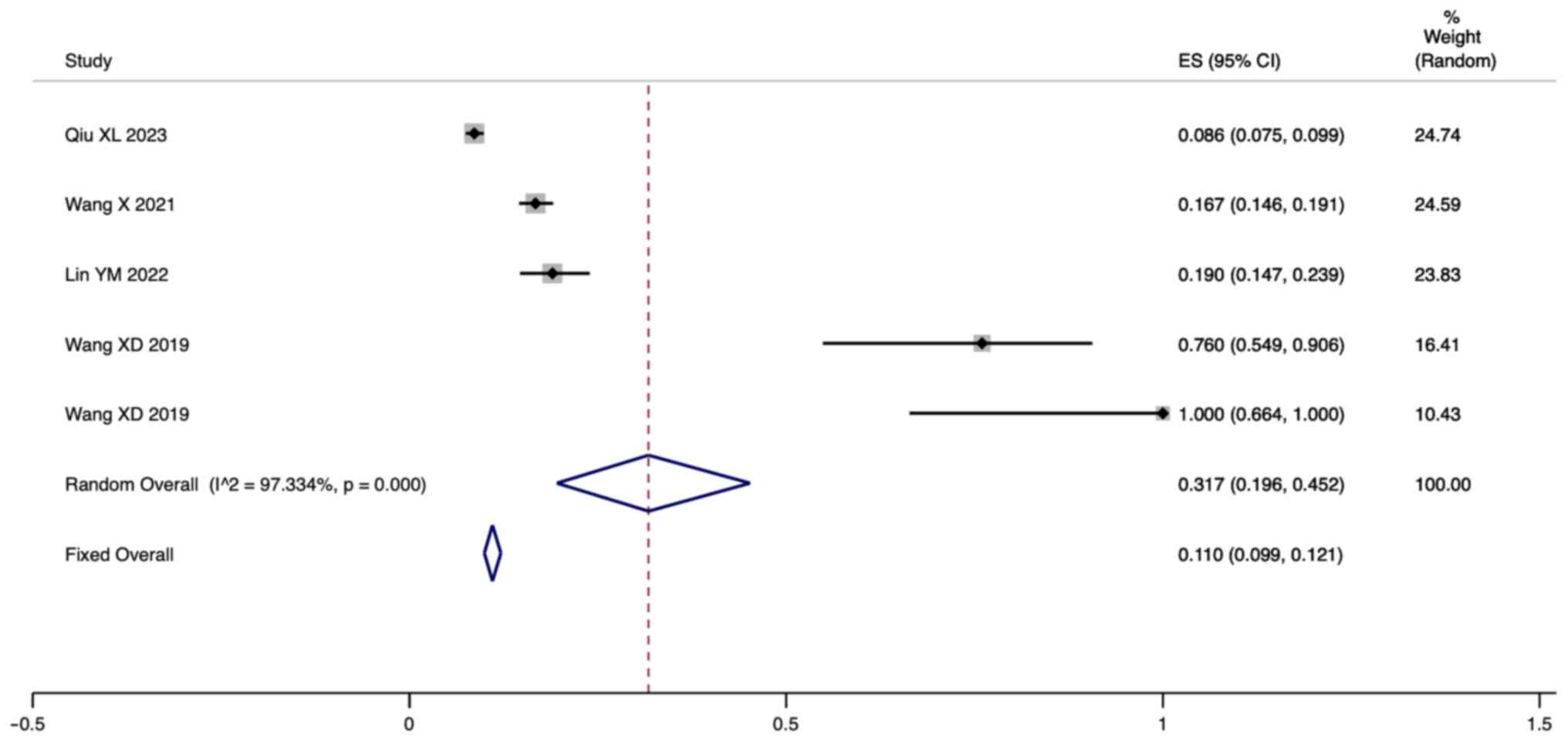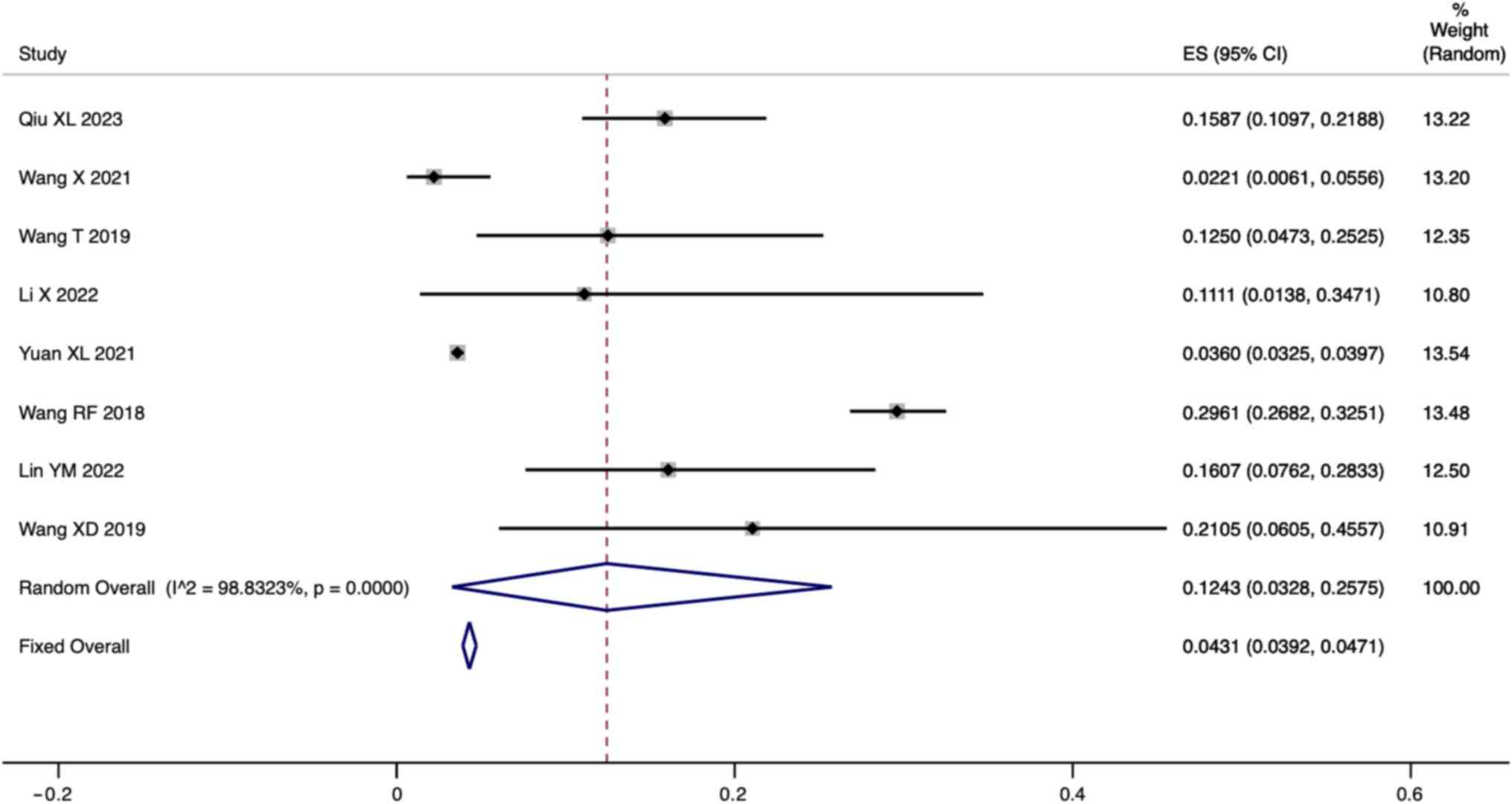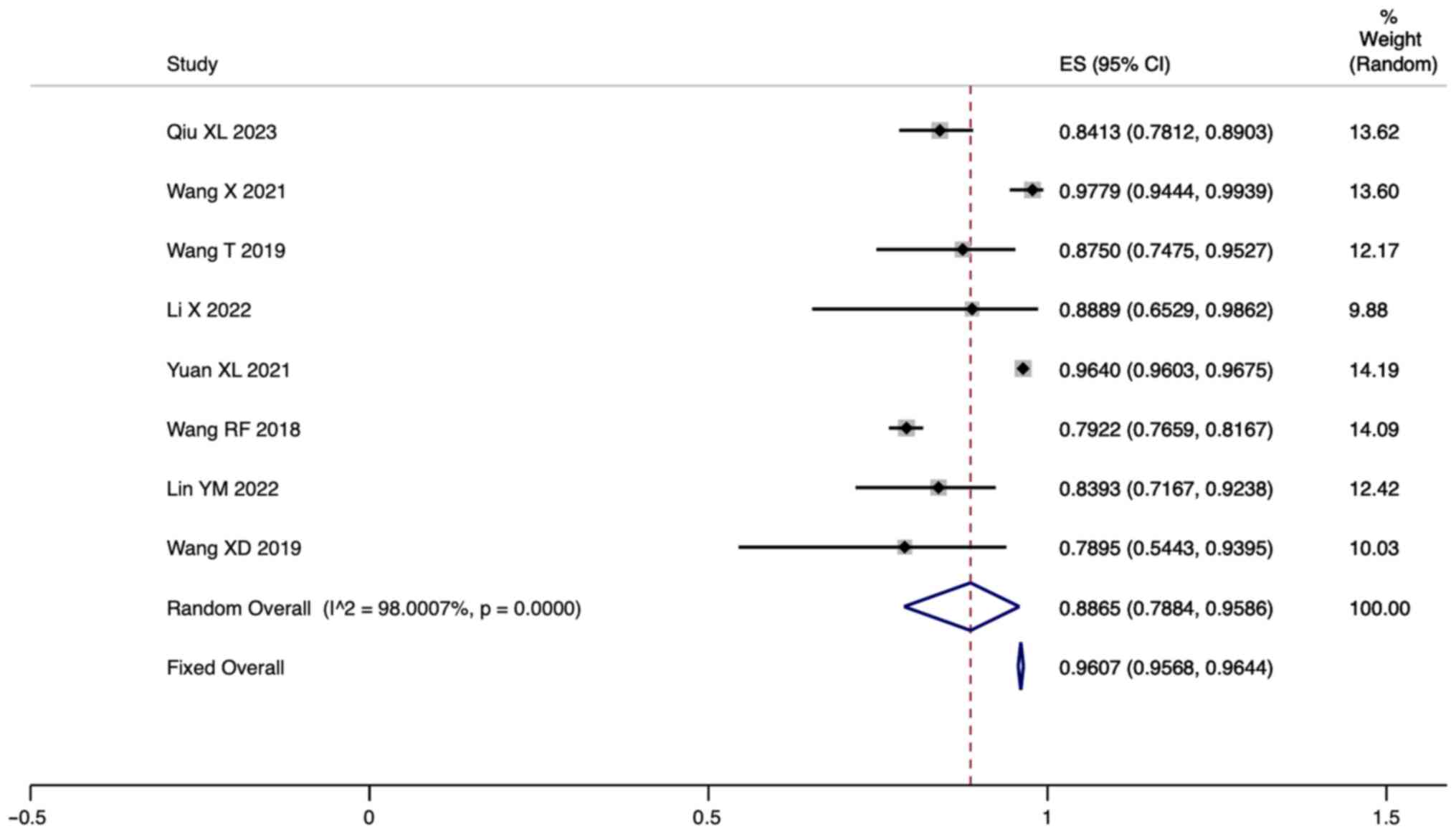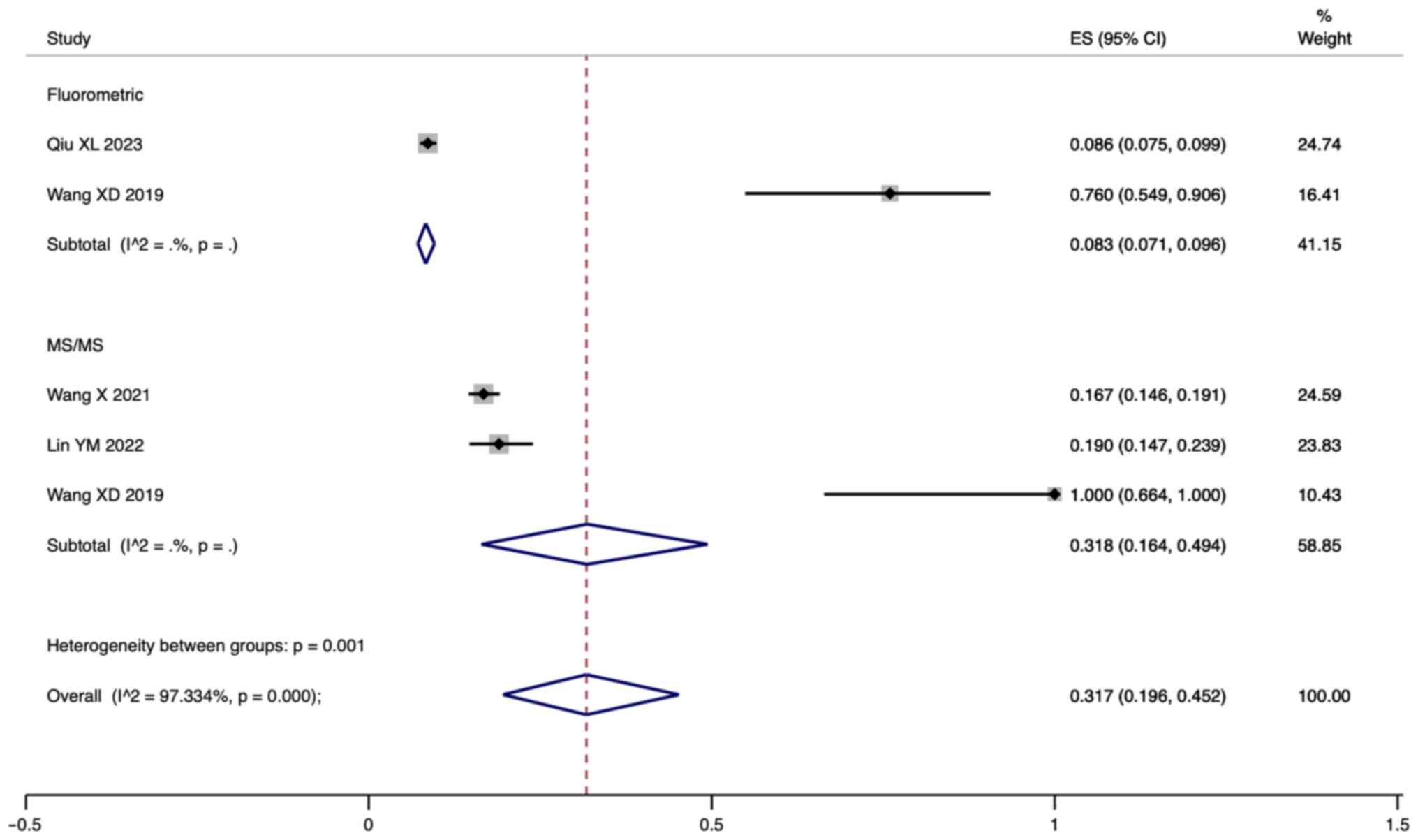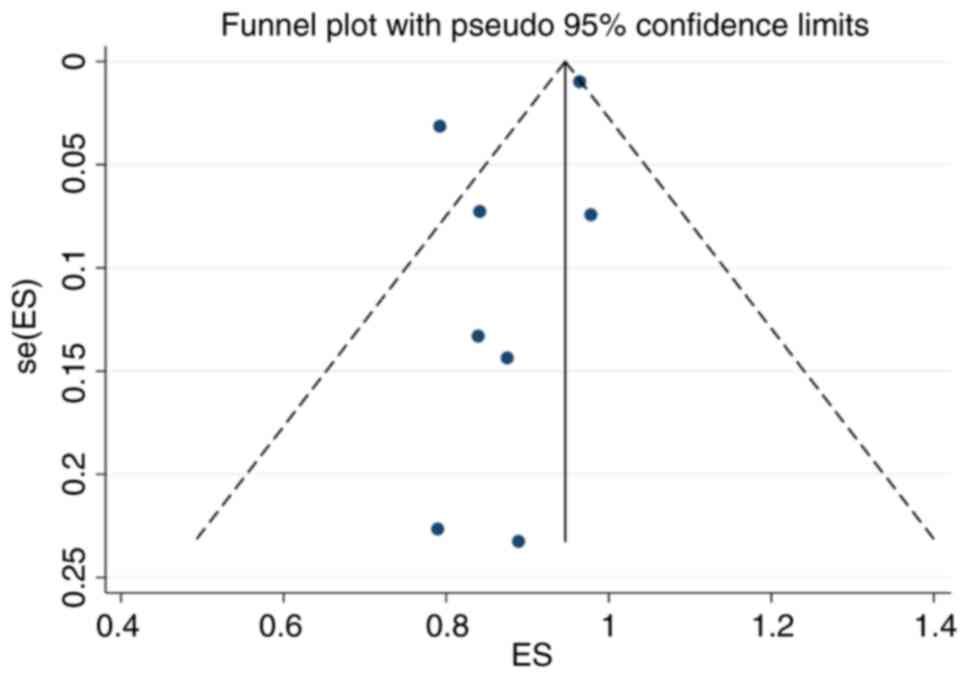Predictive value of fluorometric method and tandem mass spectrometry for hyperphenylalaninemia and its subtypes in China: A systematic review and meta‑analysis
- Authors:
- Published online on: May 10, 2024 https://doi.org/10.3892/etm.2024.12566
- Article Number: 278
-
Copyright: © Shang et al. This is an open access article distributed under the terms of Creative Commons Attribution License.
Abstract
Introduction
Hyperphenylalaninemia (HPA) occurs due to a deficiency in phenylalanine (Phe) hydroxylase, thus preventing the smooth conversion of Phe and resulting in its accumulation in the body. The inability to metabolize Phe normally leads to the accumulation of phenylketones, especially phenylacetone and phenylethylketone. One of the primary clinical features of HPA is damage to the nervous system, including delays in intellectual developmental, cognitive impairments and motor disturbances. The accumulation of phenylketones may also induce the dilation of cerebral blood vessels, causing instability in the cerebral vascular system (1). The prevalence of HPA exhibits substantial global variation. The average incidence of HPA is ~1:8,000 in Europe (2), 1:15,000 in the United States (3) and 1:12,000 in mainland China (4). If left undiagnosed and untreated in a timely manner, HPA can lead to cognitive impairment, neurodevelopmental disorders and even severe intellectual disabilities. Thus, early and highly accurate screening and diagnosis of HPA are paramount for the quality of life and long-term prognosis of affected individuals (5). In clinical practice, HPA is categorized into two distinct types: phenylalanine hydroxylase deficiency (PAHD) and tetrahydrobiopterin deficiency (BH4D). PAHD and BH4D play crucial roles in the Phe metabolic pathway. PAHD is responsible for converting Phe to tyrosine, while BH4D is involved in the regeneration of tetrahydrobiopterin, a cofactor essential for PAHD activity. When both PAHD and BH4D are deficient, the normal pathway of Phe metabolism is hindered, leading to the accumulation of phenylketones in the body and toxic effects on the organism (6).
Neonatal screening for the HPA has been implemented in China since the early 1980s, leading to the accumulation of substantial expertise spanning three decades. In 2014, Chinese experts established a consensus regarding HPA diagnosis and treatment (7). Moreover, in 2019, there was a recommendation for a consensus on dietary interventions and nutrition management for PAHD (8). The clinical diagnosis of HPA typically relies on laboratory testing, with the most commonly used methods being fluorometric assays and tandem mass spectrometry (MS/MS). These two methods are widely employed in clinical practice; however, their diagnostic accuracy and predictive value have remained the subject of ongoing research and clinical scrutiny (9). Fluorometric assays, which are relatively simple, cost-effective and amenable to large-scale application, are nonetheless associated with debates regarding its specificity and accuracy (10). By contrast, MS/MS offers higher resolution and sensitivity but requires more complex instrumentation and specialized expertise (11). Given the complexity and heterogeneity of HPA, as well as the variations among different subtypes of HPA, there is a pressing need to gain a deeper understanding of the performance of these two commonly utilized methods to improve guidance of clinical practice and neonatal screening. To address this issue, the present study aimed to conduct a comprehensive meta-analysis to assess the diagnostic value of fluorometric assays and MS/MS for HPA and its subtypes.
Materials and methods
Literature inclusion and exclusion criteria
The inclusion criteria were as follows: The study type was cross-sectional; the study reported the newborn screening and genetic features of patients with HPA; and the language was limited to English. The exclusion criteria were as follows: Repeated publication; studies without full text, incomplete information or inability to conduct data extraction; animal experiments; and reviews and systematic reviews.
Search strategy
The present meta-analysis searched the PubMed, Embase and Cochrane Library databases from inception to October 2023. The search strategies were as follows: ‘(((genetic[Title/Abstract]) OR (screening[Title/Abstract])) AND ((hyperphenylalaninemia[Title/Abstract]) OR (HPA[Title/Abstract]))) AND ((China[Title/Abstract]) OR (Chinese[Title/Abstract]))’ for PubMed; ‘screening:ab,ti AND genetic:ab,ti AND (hyperphenylalaninemia:ab,ti OR hpa:ab,ti) AND (china:ab,ti OR chinese:ab,ti)’ for Embase; and ‘((genetic):ti,ab,kw OR (screening):ti,ab,kw) AND ((hyperphenylalaninemia):ti,ab,kw OR (HPA):ti,ab,kw) AND ((China):ti,ab,kw OR (Chinese):ti,ab,kw)’ for the Cochrane Library.
Literature screening and data extraction
Two researchers independently carried out the literature search, screening and information extraction. Disagreements were resolved by discussion or by consulting a third person. The following data were extracted: Author, publication year of the article, country, study design, sample size, age, sample size of patients with suspected positive HPA, sample size of patients with confirmed HPA and screening method.
Literature quality assessment
The quality of evidence for each study was assessed by two independent researchers using the Methodological Index for Nonrandomized Studies (MINORS) scale (12). There were a total of 12 items, each with a score of 0-2 and a total score of 24. Studies were classified as moderate quality (9-16) or high quality (17-24). The Meta-analysis was performed in accordance with the relevant items in the Preferred Reporting Items for Systematic Reviews and Meta Analysis statement.
Data synthesis and statistical analysis
All the data were analyzed with STATA (15.1, StataCorp LLC) (13). The I2 and Q tests were used to evaluate heterogeneity. A P-value ≥0.1 and an I2 value ≤50% indicate that there is homogeneity between studies and in such cases, a fixed effects model was used for pooled analysis; a P-value <0.1 or an I2 value >50% indicated that there was heterogeneity and in such cases, sensitivity analysis was conducted by eliminating each included study individually and performing a summary analysis of the remaining studies to determine the source of heterogeneity. If the heterogeneity was still high, a random effects model was used, or descriptive analysis was performed instead of pooled analysis. A funnel plot and Egger's test were used to assess publication bias. Age of newborns is presented as mean ± SD.
Results
Results of the literature search
In the present meta-analysis, a total of 172 studies were retrieved from databases, including PubMed, Embase and the Cochrane Library. After eliminating duplicate studies, 91 studies remained. After screening the titles and abstracts, 55 studies remained. Ultimately, eight articles were included in the meta-analysis (Fig. 1).
Baseline characteristics and quality assessment of the included studies
A total of eight cross-sectional studies were included in this meta-analysis. The total screening population included 113,280,754 participants. All patients were newborns from China. The screening methods used were fluorometric and MS/MS. In the studies reporting sex distributions, a total of 2,429,813 boys and 2,057,178 girls were included, indicating that the sex distributions were comparable. The MINORS scores were all >16 points, indicating that the included studies were of moderate or high quality (Table I).
Results of the meta-analysis. Screening positive rate
A total of five studies reported the positive rate of newborn screening for HPA. Since there was significant heterogeneity (I2=99.39%; P=0.000), a meta-analysis was conducted through a random effects model. The pooled results showed that the positive rate of neonatal HPA screening using fluorometric assays and tandem mass spectrometry was 0.04% [95% confidence interval (CI): 0.019-0.069] (Fig. 2).
PPV. A total of five studies reported the PPV of newborn screening for HPA. Since there was significant heterogeneity (I2=97.33%; P=0.000), a meta-analysis was conducted through a random effects model. The pooled results showed that the PPV of neonatal HPA screening using fluorometric assays and tandem mass spectrometry was 31.7% (95% CI: 19.6-45.2; Fig. 3).
Incidence of HPA patients with BH4D. A total of eight studies reported the incidence of BH4D in HPA patients. Since there was significant heterogeneity (I2=98.83%, P=0.000), a meta-analysis was conducted through a random effects model. The pooled results showed that the incidence of BH4D in HPA patients was 12.43% (95% CI: 3.28-25.75; Fig. 4).
Incidence of PAHD in HPA patients. A total of eight studies reported the incidence of PAHD in HPA patients. Since there was significant heterogeneity (I2=98.00%, P=0.000), a meta-analysis was conducted through a random effects model. The pooled results showed that the incidence of PAHD in HPA patients was 88.65% (95% CI: 78.84-95.86; Fig. 5).
Subgroup analysis
The present study performed a subgroup analysis of PPVs based on different screening methods. The pooled results showed that the PPV of neonatal HPA screening using fluorometric assays was 8.3% (95% CI: 7.1-9.6; Fig. 6), while the PPV of neonatal HPA screening using tandem mass spectrometry was 31.8% (95% CI: 16.4-49.4) and the difference in the percentage of positive HPA signals between the two screening methods was statistically significant (P=0.001).
Sensitivity analysis
The present study revealed that none of the studies had an outsized effect on the pooled results of the meta-analysis, which suggested that the results of the meta-analysis were stable and reliable.
Publication bias
The funnel plot drawn in the present study is shown in Fig. 7. The funnel plot was basically symmetrical and the P-value of Egger's test was 0.204, indicating that there was no obvious publication bias.
Discussion
Newborn screening for Phe metabolism defects is a highly effective approach for the early identification and swift management of HPA. This can significantly enhance survival and overall quality of life for individuals affected by this condition. The rate of HPA positivity varies by country, region and race. The positive rate is estimated to be 1/43,449 in Brazil (22), 1/10,000 in Europe (23), 1/70,000 in Japan (24) and 1/19,000-1/13,500 in the United States (25). In the present study, the pooled results showed that the positivity rate of neonatal HPA screening in China using fluorometric assays or MS/MS was 0.04% (1/2,500). This shows that the positivity rate in China is higher than that in other countries. A comparison with similar international studies showed that the positivity rate of HPA in China is relatively high, which may reflect the genetic heterogeneity and geographic variation of the population. However, there are some similarities between our findings and those of other countries, such as the positive rate of 1/10,000 in Europe (23). These comparisons provide insight into the differences in HPA performance across populations, providing a basis for more consistent screening standards worldwide.
The present study further analyzed the PPVs of fluorometric assays and MS/MS screening for HPA. The pooled results showed that the PPV of neonatal HPA screening using fluorometric assays and tandem mass spectrometry was 31.7% (95% CI: 19.6-45.2). Subgroup analysis revealed that the PPV of neonatal HPA screening using fluorometric assays was 8.3% (95% CI: 7.1-9.6), the PPV of neonatal HPA screening using MS/MS was 31.8% (95% CI: 16.4-49.4) and the difference in the percentage of positive HPA signals between the two screening methods was statistically significant (P=0.001). It is suggested that the PPV of MS/MS is greater and has greater predictive value. Consistent with the findings of other international studies, MS/MS has shown greater accuracy and reliability in neonatal phenylketonuria screening. For example, Perko et al (9) found that the PPV for MS/MS in their sample was 5.36, compared with 3.21 for fluorometric assays. This is consistent with the findings of the present study, indicating the superior performance of MS/MS in HPA screening. The implementation of MS/MS technology represents a major breakthrough in neonatal HPA screening. This technology, known for its high throughput, specificity and sensitivity, has found extensive use in the identification of inherited metabolic disorders. MS/MS technology outperforms fluorometric assays by allowing for the concurrent assessment of Phe levels, Tyr levels and the Phe/Tyr ratio. This capability substantially diminishes the occurrence of false-positive results in HPA screening. Furthermore, MS/MS technology has the capacity to identify >inherited metabolic disorders (comprising amino acid, fatty acid and organic acid disorders) within a single cost-effective test, thereby meeting the requirements of newborn screening programs efficiently (26). The screening of newborns for HPA is highly important for future screening strategies and public health policies. The results of the present study revealed differences between fluorescence and MS/MS in HPA screening, providing guidance for the development of more precise and effective screening methods. Specifically, the present study revealed that MS/MS has a greater PPV for the diagnosis of HPA, highlighting its importance as an outstanding diagnostic tool in clinical practice. Future screening strategies may tend to more widely adopt MS/MS technology to enhance the accuracy and reliability of screening. In terms of public health policy, the results of the present study have significant implications for the development of early intervention policies for the HPA. As HPA can potentially lead to intellectual developmental delay and neurological damage, timely early intervention is crucial for the long-term prognosis of patients. Therefore, the management and treatment policies for HPA-positive patients should place increased emphasis on the importance of early intervention to minimize neurological damage and cognitive impairments.
In addition, the pooled results suggested that the number of HPA patients with PAHD was significantly greater than the number of HPA patients with BH4D. BH4D, although less prevalent than other forms of HPA, can lead to significant developmental challenges if it is managed solely with a Phe-restricted diet. It is vital to distinguish BH4D from other conditions, such as PAHD, because individuals with BH4D require prompt treatment with BH4 and neurotransmitter precursors to mitigate the risk of neurological deterioration (27).
There were several limitations to the present study. First, heterogeneity existed in the present study, which may be due to differences in the basic characteristics of the population. However, the insufficient number of studies made it impossible to analyze the source of heterogeneity, which is a problem that needs to be overcome in the future. Second, for the comparison of the diagnostic value of fluorometric assays and MS/MS, only the PPV has been reported and there is a lack of data on sensitivity and specificity. Additionally, no individual study has specifically explored the differences in diagnostic and prognostic value of the fluorometric method and MS/MS for hyperphenylalaninemia patients across different countries. Future efforts should focus on conducting clinical research to comprehensively analyze this aspect.
In summary, the PPV of neonatal HPA screening using MS/MS was significantly greater than that of fluorometric assays, underscoring MS/MS as a superior diagnostic tool in clinical practice. The elevated PPV of MS/MS indicates its heightened accuracy and reliability in diagnosing HPA and its subtypes, namely, PAHD and BH4D.
This finding has significant practical implications for real clinical practice. First, the high PPV of MS/MS in neonatal HPA screening implies its greater accuracy and reliability, positioning it as the preferred diagnostic modality. In clinical practice, this signifies that health care professionals can rely more confidently on MS/MS for early HPA diagnosis, enabling timely intervention and management. Second, the outstanding performance of MS/MS in diagnosing HPA and its subtypes (PAHD and BH4D) underscores its importance in formulating individualized treatment plans. The precision of identifying specific subtypes aids medical teams in choosing targeted treatment approaches, enhancing therapeutic outcomes. This has a positive effect on improving the quality of life and long-term prognosis of patients. Thus, the results of the present study not only provided crucial guidance for clinicians in selecting HPA diagnostic methods but also have a direct and practical impact on improving patient management and treatment outcomes. This emphasized the direct applicability of the research in actual medical practice, offering a reliable basis for health care decision-making.
The results of the present meta-analysis provided valuable insights into the predictive value of different screening methods for HPA. Future research should further explore the sensitivity and specificity of these methods to provide a more comprehensive understanding of their diagnostic performance. Additionally, exploring the factors contributing to the observed heterogeneity in our analysis could enhance the precision of screening outcomes.
The practical implications of the findings of the present study underscore the importance of incorporating MS/MS technology in routine newborn screening programs, particularly in regions with a higher prevalence of HPA. This approach not only enhances diagnostic accuracy but also allows for the concurrent assessment of various metabolic disorders, making it a cost-effective and efficient tool in clinical practice.
As the field of metabolic disorders evolves, continuous research is essential to refine screening methods, improve diagnostic precision and tailor treatment strategies based on the distinct characteristics of PAHD and BH4D. The present study laid the groundwork for future investigations and contributed to ongoing advancements in the early diagnosis and management of hyperphenylalaninemia.
Acknowledgements
Not applicable.
Funding
Funding: The present study was supported by 2020 research topic of Sichuan Provincial Health Commission (approval no. 20PJ270) and 2019 Sichuan Medical Research project (approval no. S19027).
Availability of data and materials
The present study has been officially registered on the INPLASY website (https://inplasy.com/), with the registration number INPLASY202430036 and DOI number 10.37766/inplasy2024.3.0036. The data generated in the present study may be requested from the corresponding author.
Authors' contributions
ZS, PX and KP wrote the manuscript and made substantial contributions to study conception and design. JL, CH and WX participated in the acquisition of data and the literature revie. YH and LT participated in data extraction and literature quality assessment. LT, QL and SL participated in data synthesis and statistical analysis. ZS and CH confirm the authenticity of all the raw data. All authors read and approved the final manuscript.
Ethics approval and consent to participate
Not applicable.
Patient consent for publication
Not applicable.
Competing interests
The authors declare that they have no competing interests.
References
|
van Spronsen FJ, Blau N, Harding C, Burlina A, Longo N and Bosch AM: Phenylketonuria. Nat Rev Dis Primers. 7(36)2021.PubMed/NCBI View Article : Google Scholar | |
|
Loeber JG: Neonatal screening in Europe; the situation in 2004. J Inherit Metab Dis. 30:430–438. 2007.PubMed/NCBI View Article : Google Scholar | |
|
National Institutes of Health Consensus Development Panel: national institutes of health consensus development conference statement. Phenylketonuria: Screening and management, October 16-18, 2000. Pediatrics. 108:972–982. 2001.PubMed/NCBI View Article : Google Scholar | |
|
Gu X, Wang Z, Ye J, Han L and Qiu W: Newborn screening in China: Phenylketonuria, congenital hypothyroidism and expanded screening. Ann Acad Med Singap. 37 (Suppl 12):S107–S104. 2008.PubMed/NCBI | |
|
Mitchell JJ, Trakadis YJ and Scriver CR: Phenylalanine hydroxylase deficiency. Genet Med. 13:697–707. 2011.PubMed/NCBI View Article : Google Scholar | |
|
Blau N, Hennermann JB, Langenbeck U and Lichter-Konecki U: Diagnosis, classification, and genetics of phenylketonuria and tetrahydrobiopterin (BH4) deficiencies. Mol Genet Metab. 104 (Suppl 1):S2–S9. 2011.PubMed/NCBI View Article : Google Scholar | |
|
Yang Y and Ye Y: Subspecial Group of Endocrine, Hereditary and Metabolic Diseases; Society of Pediatrics, Chinese Medical Association; Newborn Screening Committee of Professional Society of Birth Defect Prevention and Control; Chinese Assocation of Preventive Medical. Consensus about the diagnosis and treatment of hyperphenylalaninemia. Zhonghua Er Ke Za Zhi. 52:420–425. 2014.PubMed/NCBI(In Chinese). | |
|
Subspecialty Group of Newborn Screening, Society of Birth Defects Prevention and Control, Chinese Preventive Medicine Association; Subspecialty Group of Clinical Nutrition, the Society of Pediatrics, Chinese Medical Association; Subspecialty Committee of Clinical Biochemistry and Genetics, the Society of Medical Genetics, Chinese Medical Doctor Association; Subspecialty Group of Clinical Genetics. Consensus statement on dietary treatment and nutritional management for phenylalanine hydroxylase deficiency. Zhonghua Er Ke Za Zhi. 57:405–409. 2019.PubMed/NCBI View Article : Google Scholar : (In Chinese). | |
|
Perko D, Groselj U, Cuk V, Iztok Remec Z, Zerjav Tansek M, Drole Torkar A, Krhin B, Bicek A, Oblak A, Battelino T and Repic Lampret B: Comparison of tandem mass spectrometry and the fluorometric method-parallel phenylalanine measurement on a large fresh sample series and implications for newborn screening for phenylketonuria. Int J Mol Sci. 24(2487)2023.PubMed/NCBI View Article : Google Scholar | |
|
Feng S, Mei J, Yang L, Luo P, Wang X, Wang Y, Yao J, Cui L, Pan L, Wang Z and Xin L: Benzene derivatives from ink lead to false positive results in neonatal hyperphenylalaninemia screening with ninhydrin fluorometric method. Int J Neonatal Screen. 6(14)2020.PubMed/NCBI View Article : Google Scholar | |
|
Groselj U, Murko S, Zerjav Tansek M, Kovac J, Trampus Bakija A, Repic Lampret B and Battelino T: Comparison of tandem mass spectrometry and amino acid analyzer for phenylalanine and tyrosine monitoring--implications for clinical management of patients with hyperphenylalaninemia. Clin Biochem. 48:14–18. 2015.PubMed/NCBI View Article : Google Scholar | |
|
Slim K, Nini E, Forestier D, Kwiatkowski F, Panis Y and Chipponi J: Methodological index for non-randomized studies (minors): Development and validation of a new instrument. ANZ J Surg. 73:712–716. 2003.PubMed/NCBI View Article : Google Scholar | |
|
Ma Y, Huo X, Kong S, Xu W, Zhao W and Zhu M: A review about C-TIRADS, ACR-TIRADS, and K-TIRADS combined with real-time tissue elastography to diagnose thyroid nodules. Discov Med. 35:1–10. 2023.PubMed/NCBI View Article : Google Scholar | |
|
Qiu X, Zhao P, Luo J, Li G, Deng L, Zeng Y, Xu L and Zhou J: Biochemical and molecular features of tetrahydrobiopterin deficiency in Fujian Province, southeastern China. Front Genet. 14(1250568)2023.PubMed/NCBI View Article : Google Scholar | |
|
Wang X, Wang Y, Ma D, Zhang Z, Li Y, Yang P, Sun Y and Jiang T: Neonatal screening and genotype-phenotype correlation of hyperphenylalaninemia in the Chinese population. Orphanet J Rare Dis. 16(214)2021.PubMed/NCBI View Article : Google Scholar | |
|
Wang T, Ma J, Zhang Q, Gao A, Wang Q, Li H, Xiang J and Wang B: Expanded newborn screening for inborn errors of metabolism by tandem mass spectrometry in Suzhou, China: Disease spectrum, prevalence, genetic characteristics in a Chinese population. Front Genet. 10(1052)2019.PubMed/NCBI View Article : Google Scholar | |
|
Li X, He J, He L, Zeng Y, Huang X, Luo Y and Li Y: Spectrum analysis of inherited metabolic disorders for expanded newborn screening in a Central Chinese population. Front Genet. 12(763222)2022.PubMed/NCBI View Article : Google Scholar | |
|
Yuan X, Zhu J, Liu H, Xiang L, Yao Y, Li Q, Deng K and Li X: Birth prevalence of tetrahydrobiopterin deficiency in China: Data from the national newborn screening program, 2013-2019. J Pediatr Endocrinol Metab. 34:835–841. 2021.PubMed/NCBI View Article : Google Scholar | |
|
Wang R, Shen N, Ye J, Han L, Qiu W, Zhang H, Liang L, Sun Y, Fan Y, Wang L, et al: Mutation spectrum of hyperphenylalaninemia candidate genes and the genotype-phenotype correlation in the Chinese population. Clin Chim Acta. 481:132–138. 2018.PubMed/NCBI View Article : Google Scholar | |
|
Lin Y, Lin W, Su R, Zheng Z, Fu Q and Wang G: Newborn screening and genetic features of patients with hyperphenylalaninemia in a southern Chinese population. Clin Chim Acta. 535:13–18. 2022.PubMed/NCBI View Article : Google Scholar | |
|
Wang X, He Y, Jiang Y, Feng X, Zhang G, Xia Z and Zhou Y: Screening and mutation analysis of hyperphenylalaninemia in newborns from Xiamen, China. Clin Chim Acta. 498:161–166. 2019.PubMed/NCBI View Article : Google Scholar | |
|
Ramalho AR, Ramalho RJ, Oliveira CR, Magalhães MM, Santos EG, Sarmento PM, Matos DO, Oliveira MC, Oliveira AL and Aguiar-Oliveira MH: Evaluation of effectiveness and outcome of PKU screening and management in the State of Sergipe, Brazil. Arq Bras Endocrinol Metabol. 58:62–67. 2014.PubMed/NCBI View Article : Google Scholar | |
|
Steinfeld R, Kohlschütter A, Ullrich K and Lukacs Z: Efficiency of long-term tetrahydrobiopterin monotherapy in phenylketonuria. J Inherit Metab Dis. 27:449–453. 2004.PubMed/NCBI View Article : Google Scholar | |
|
Aoki K: Long term follow-up of patients with inborn errors of metabolism detected by the newborn screening program in Japan. Southeast Asian J Trop Med Public Health. 34 (Suppl 3):S19–S23. 2003.PubMed/NCBI | |
|
Kaye CI: Committee on Genetics. Accurso F, La Franchi S, Lane PA, Hope N, Sonya P, G Bradley S and Michele ALP: Newborn screening fact sheets. Pediatrics. 118:e934–e963. 2006.PubMed/NCBI View Article : Google Scholar | |
|
Lin Y, Zheng Q, Zheng T, Zheng Z, Lin W and Fu Q: Expanded newborn screening for inherited metabolic disorders and genetic characteristics in a southern Chinese population. Clin Chim Acta. 494:106–111. 2019.PubMed/NCBI View Article : Google Scholar | |
|
Opladen T, López-Laso E, Cortès-Saladelafont E, Pearson TS, Sivri HS, Yildiz Y, Assmann B, Kurian MA, Leuzzi V, Heales S, et al: Consensus guideline for the diagnosis and treatment of tetrahydrobiopterin (BH4) deficiencies. Orphanet J Rare Dis. 15(126)2020.PubMed/NCBI View Article : Google Scholar |



